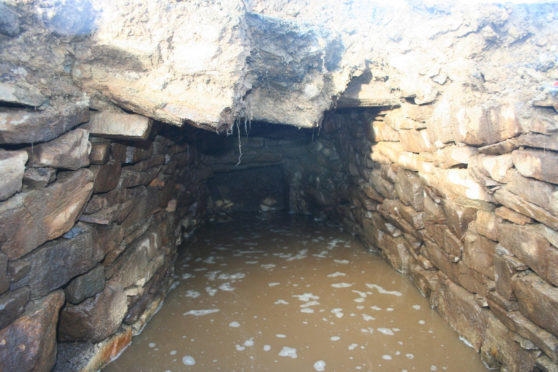A 2,000-year-old ‘fridge’ has held up a home being built in the Outer Hebrides.
For the ancient larder was discovered right under where fisherman Murdo Campbell was planning to build his four bedroom home.
The ancient underground chamber, dating from around the time when Christ walked the Earth, was unearthed during work to build the house at the north end of the Isle of Lewis.
A digger driver was clearing Murdo Campbell’s site at Knockaird at Ness when he was stopped in his tracks by an obstruction.
Realising it was an old structure, he contacted local archaeologists Chris and Rachel Barrowman, who also live in Ness.
The husband and wife time detectives soon realised it was an Iron Age soutterrain.
Now building work has halted on the site while the 60-ft long find is recorded by experts.
Western Isles Council’s archaeologist Kevin Murphy is also being called in to examine the structure for its significance.
Mrs Barrowman said theories on the purpose of the stone-lined, flat stone-roofed structures included that it was used to store food.
It is understood it to be the sixth to be recorded in the area.
“A couple of days ago we had a call from the digger driver. He was clearing the land for the house and uncovered the structure. At first he thought it was something modern but when he saw what it was he realised it was a lot older,” said Mrs Barrowman.
“It tapers at one end to about 80cms (2.6 feet) which would be the entrance and is just under a metre (3.3 feet) at its widest. It is a bit like a tadpole shape. It would have probably been used for food storage and maybe even peats. It was a sort of ancient fridge.
“The structure is directly under where the house is going. So we have been recording it. We thought there might be a house there too, but there is no sign of anything else.
“This soutterrain was underground – any buildings would have been above ground. It, and other evidence in and around Ness, show that the area was well populated 2000 years ago.
“The builder has chosen to stop so it can be recorded.”
Mr Barrowman added it was not always certain what the exact use of soutterrains was.
“They are usually associated with what are known as Atlantic roundhouses, or wheelhouses, of the later Iron Age,” he said.
Mr Campbell was understood to be away yesterday.
